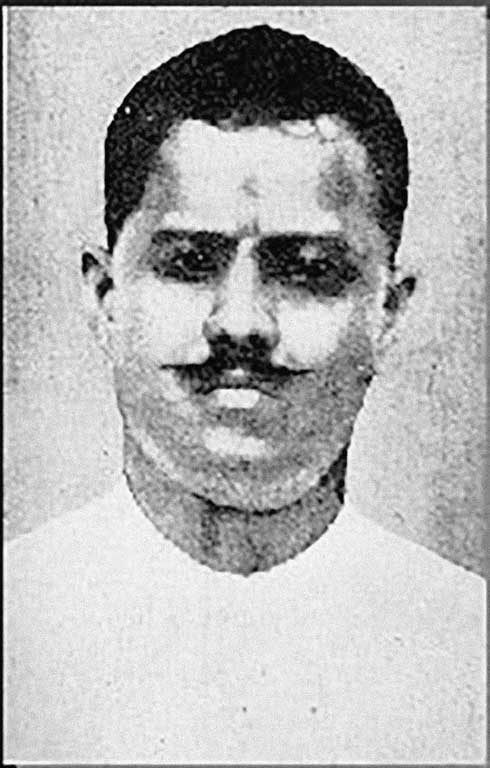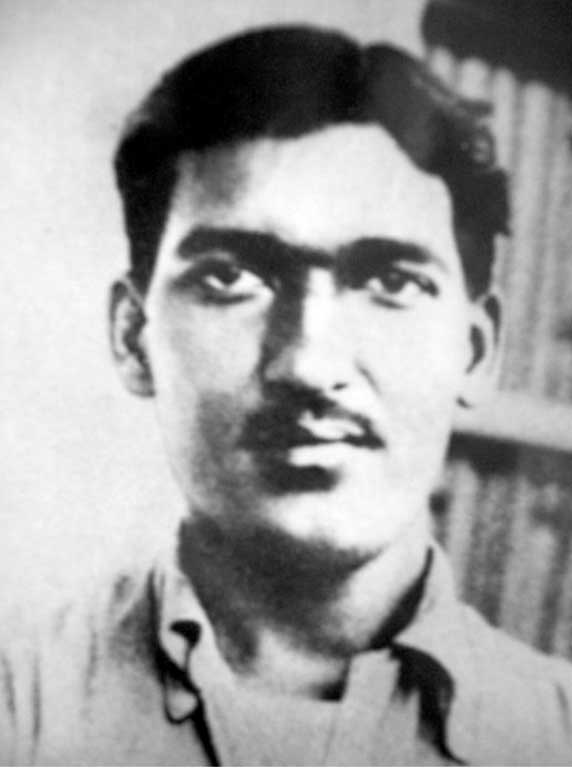(On the occasion of their martyrdom anniversary, Liberation pays tribute to freedom fighters and revolutionaries Ramprasad Bismil and Ashfaqulla Khan, who were hanged by the British colonial Raj on 19 December 1927).
The memory of the friendship and comradeship of the revolutionary freedom fighters Bismil and Ashfaq has much to offer us in our troubled times today, when hate-mongering politics seeks to drive a communal wedge amongst people and justify the lynching and massacre of Muslims in India.
Ramprasad Bismil
 Ramaprasad Bismil, Ashfaqulla Khan, Rajendra Lahiri, and Roshan Singh, along with Chandrashekhar Azad, were among the revolutionaries who carried out the daring Kakori train robbery: looting the treasury of the colonial Government to fund the war for an independent India. Azad could not be arrested, but these four were arrested. Lahiri was hanged in Gonda jail on 17 December 1927; Bismil, Ashfaq and Roshan Singh were hanged in Gorakhpur, Faizabad, and Allahabad jails respectively on 19 December 1927. A memorial to Bismil stands inside Gorakhpur jail; one for Ashfaq stands in his home town Shahajahanpur where he ws buried; one for Roshan Singh stands in Allahabad and one for Lahiri in Gonda. What message do these freedom fighters, martyred in Uttar Pradesh, have for today’s India, where the Government in Uttar Pradesh and in the Centre are fountainheads of communal fascist politics?
Ramaprasad Bismil, Ashfaqulla Khan, Rajendra Lahiri, and Roshan Singh, along with Chandrashekhar Azad, were among the revolutionaries who carried out the daring Kakori train robbery: looting the treasury of the colonial Government to fund the war for an independent India. Azad could not be arrested, but these four were arrested. Lahiri was hanged in Gonda jail on 17 December 1927; Bismil, Ashfaq and Roshan Singh were hanged in Gorakhpur, Faizabad, and Allahabad jails respectively on 19 December 1927. A memorial to Bismil stands inside Gorakhpur jail; one for Ashfaq stands in his home town Shahajahanpur where he ws buried; one for Roshan Singh stands in Allahabad and one for Lahiri in Gonda. What message do these freedom fighters, martyred in Uttar Pradesh, have for today’s India, where the Government in Uttar Pradesh and in the Centre are fountainheads of communal fascist politics?
All of them were founding members of the Hindustan Socialist Republican Association (HSRA), which was committed not only to freeing India from colonial rule but to achieving a revolution that would free India’s people from inequality, oppression, and exploitation of every kind.
Ramprasad Bismil and Ashfaqulla Khan ‘Warsi’ shared an especially close bond. They were both Urdu poets: Bismil’s poem Sarfaroshi ki tamanna (Aspiration for sacrifice) was a virtual anthem for the HSRA revolutionaries. Ashfaq was inspired by Bismil’s example to join the revolutionary movement. And their martyrdom sealed the bond.
They were deeply conscious of the attempts to sow communal poison to divide the freedom movement and India’s people: remember, the Hindu Mahasabha had existed since 1906, the Rashtriya Swayamsevak Sangh had been formed in 1925, and attempts by various Hindu and Muslim leaders to pit the two communities against each other were rife. Bismil’s last message resonates with the hope that their sajhi shahadat, sajhi virasat (shared martyrdom, shared legacy) will put paid to such communal divisions for good.
In the January 1928 issue of the Ghadarite revolutionaries’ journal Kirti, Bhagat Singh wrote a piece titled ‘The Last Message of Martyr of the Nation Shri Ram Prasad Bismil,’ translating Bismil’s words into Punjabi. The message itself was written by Bismil on 16 December 1927 – three days before his execution.
In this message, Bismil points out that the British colonial rulers who claimed that the death sentence for the Kakori convicts (who were after all guilty of mere robbery) could not be remitted because it would embolden others, showed much leniency towards violent communal rioters:
“Sir William Maurice had himself remitted the death sentences of Shahjahanpur and Allahabad riots. And these sentences were remitted when riots were taking place every day. If reducing the sentence would have emboldened others then same thing could be said about communal riots also. But here the issue was different.” In other words, communal politics, however violent, posed no threat to the British colonial rule, but revolutionary anti-colonial movements did!
And here was Bismil’s final, fervent appeal to the people of his country: “If a devout Muslim like Ashfaq could be right hand man of an Arya Samajist like Ram Prasad in revolutionary movement, then why can’t other Hindus and Muslims unite forgetting their petty interests? Now my only request to countrymen is that if they have even an iota of sorrow at our death, then, with whatever means, they must establish Hindu-Muslim unity; that was our last wish and this only can be our memorial.”
Ashfaqulla Khan
 Ashfaq’s own last letters and statements reflect the love the HSRA revolutionaries had for each other, transcending all boundaries of religion and region. Ashfaq’s letter to his comrade Sachinder Nath Bakshi’s sister addresses the latter as ‘My dear didi’, offers ‘Bandey charan’ (touching the feet) of Bakshi’s father whom Ashfaq too calls ‘Baba’. It’s as though Bakshi’s family members were his own. Ashfaq ended his letter: “It is my desire to see you all once more in my life. You may come if possible. …Let Bakshi know about me. I regard you as my sister and you would not forget me. Be cheerful I am dying like Heroes.”
Ashfaq’s own last letters and statements reflect the love the HSRA revolutionaries had for each other, transcending all boundaries of religion and region. Ashfaq’s letter to his comrade Sachinder Nath Bakshi’s sister addresses the latter as ‘My dear didi’, offers ‘Bandey charan’ (touching the feet) of Bakshi’s father whom Ashfaq too calls ‘Baba’. It’s as though Bakshi’s family members were his own. Ashfaq ended his letter: “It is my desire to see you all once more in my life. You may come if possible. …Let Bakshi know about me. I regard you as my sister and you would not forget me. Be cheerful I am dying like Heroes.”
Another very significant statement of Ashfaqulla Khan’s is worth recalling here. This statement reflects how he, while being a believing Muslim, was drawn to Communist ideology and shared the same vision as the atheist Bhagat Singh for revolution: “I consider the alien rule an evil and at the same time, I hate any democratic Indian rule where the weak are denied their rights, or if it is the creation of the rich and landlords, or there is no equal participation of the farmers and workers, or if the laws of the Government are made on the basis of inequality and disparity. If India becomes free and our brother countrymen take the reins of Government from the white masters and if the inequality persists between the rich and the poor and the landlord and the tenant, I pray to God not to give me such freedom till equality is established in His Creation. Let me be dubbed a Communist for these ideas, I damn care.” (To Make The Deaf Hear: Ideology And Programme Of Bhagat Singh And His Comrades, S Irfan Habib, p 28)
Liberation Archive
- 2001-2010
-
2011-2020
- 2011
- 2012
- 2013
- 2014
- 2015
- 2016
-
2017
- January-2017
- February-2017
- March-2017
- April-2017
- May-2017
- June-2017
- July-2017
- August-2017
- September-2017
- October-2017
- November-2017
-
December-2017
- Disturbing Questions Over Death Of CBI Judge Justice Loya
- Farmers Hold Massive Kisan Mukti Sansad At Parliament Street
- Mobs and Governments Are Silencing Freedom Of Expression
- Probe The Rafale Deal Scam
- Das Kapital And Contemporary Capitalism
- Education Not Hate! Jobs not Mobs!
- Massive Assertion of Working Class In Front Of Parliament
- November Forever : Inspiring Legacy, Profound Lessons
- One Year Of Demonetisation: An Economic War On People
- Remembering Shaheed Kartar Singh Sarabha
- Resistance To Sanghi Propaganda And Violence
- Shared Martyrdom, Shared Legacy: The Immortal Comradeship of Bismil-Ashfaq
- 2018
- 2019
- 2020
- 2021-2030
Charu Bhawan, U-90, Shakarpur, Delhi 110092
Phone: +91-11-42785864 | Fax:+91-11-42785864 | +91 9717274961
E-mail: info@cpiml.org







